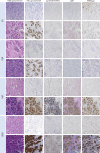H&E to IHC virtual staining methods in breast cancer: an overview and benchmarking
- PMID: 40603634
- PMCID: PMC12222792
- DOI: 10.1038/s41746-025-01741-9
H&E to IHC virtual staining methods in breast cancer: an overview and benchmarking
Abstract
Immunohistochemistry (IHC) is crucial for the clinical categorisation of breast cancer cases. Deep generative models may offer a cost-effective alternative by virtually generating IHC images from hematoxylin and eosin samples. This review explores the state-of-the-art in virtual staining for breast cancer biomarkers (HER2, PgR, ER and Ki-67) and benchmarks several models on public datasets. It serves as a resource for researchers and clinicians interested in applying or developing virtual staining techniques.
© 2025. The Author(s).
Conflict of interest statement
Competing interests: The authors declare no competing interests.
Figures








Similar articles
-
Cost-effectiveness of using prognostic information to select women with breast cancer for adjuvant systemic therapy.Health Technol Assess. 2006 Sep;10(34):iii-iv, ix-xi, 1-204. doi: 10.3310/hta10340. Health Technol Assess. 2006. PMID: 16959170
-
Development and clinical validation of deep learning-based immunohistochemistry prediction models for subtyping and staging of gastrointestinal cancers.BMC Gastroenterol. 2025 Jul 1;25(1):494. doi: 10.1186/s12876-025-04045-0. BMC Gastroenterol. 2025. PMID: 40597706 Free PMC article.
-
A rapid and systematic review of the clinical effectiveness and cost-effectiveness of paclitaxel, docetaxel, gemcitabine and vinorelbine in non-small-cell lung cancer.Health Technol Assess. 2001;5(32):1-195. doi: 10.3310/hta5320. Health Technol Assess. 2001. PMID: 12065068
-
Leveraging a foundation model zoo for cell similarity search in oncological microscopy across devices.Front Oncol. 2025 Jun 18;15:1480384. doi: 10.3389/fonc.2025.1480384. eCollection 2025. Front Oncol. 2025. PMID: 40606969 Free PMC article.
-
Systemic pharmacological treatments for chronic plaque psoriasis: a network meta-analysis.Cochrane Database Syst Rev. 2021 Apr 19;4(4):CD011535. doi: 10.1002/14651858.CD011535.pub4. Cochrane Database Syst Rev. 2021. Update in: Cochrane Database Syst Rev. 2022 May 23;5:CD011535. doi: 10.1002/14651858.CD011535.pub5. PMID: 33871055 Free PMC article. Updated.
References
-
- Funkhouser, W. K. Pathology: the clinical description of human disease. In Essential Concepts in Molecular Pathology (Second Edition), 177–190 (2020).
-
- Veta, M., Pluim, J. P. W., van Diest, P. J. & Viergever, M. A. Breast cancer histopathology image analysis: a review. IEEE Trans. Biomed. Eng.61, 1400–1411 (2014). - PubMed
-
- Acs, B., Rantalainen, M. & Hartman, J. Artificial intelligence as the next step towards precision pathology. J. Intern. Med.288, 62–81 (2020). - PubMed
Publication types
Grants and funding
LinkOut - more resources
Full Text Sources
Research Materials
Miscellaneous

